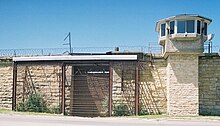Joliet State Prison

East gate of the prison
|
|
| Location | Joliet, Illinois |
|---|---|
| Coordinates | 41°32′49″N 88°04′27″W / 41.54694°N 88.07417°WCoordinates: 41°32′49″N 88°04′27″W / 41.54694°N 88.07417°W |
| Status | Closed in 2002 |
| Opened | 1858 |
Joliet Correctional Center (originally known as Illinois State Penitentiary, colloquially as Joliet Prison, Joliet Penitentiary and the Collins Street Prison) was a prison in Joliet, Illinois, America from 1858 to 2002. It is featured in the motion picture The Blues Brothers as the prison from which Jake Blues is released at the beginning of the movie. It is also the location for the first season of Fox Network's Prison Break television show, the movie Let's Go to Prison, and Netflix’s Mindhunter.
Joliet Correctional Center, which was a completely separate prison from Stateville Correctional Center in nearby Crest Hill, opened in 1858. The prison was built with convict labor leased by the state to contractor Lorenzo P. Sanger and warden Samuel K. Casey. The limestone used to build the prison was quarried on the site. The first 33 inmates arrived from Alton in May 1858 to begin construction; the last prisoners were transferred in July 1860. Both criminals and prisoners of war were confined there during the Civil War. The first corrections officer to be killed there was Joseph Clark in 1865. By 1872 the population had reached 1,239, a record number for a single prison. From the 1870s the prison had work contracts with local businesses.
The penitentiary's original plans included a one-hundred cell "Female Cell House" located inside the male penitentiary. Female prisoners were housed adjacent to men's cells from 1859 until 1870, when they were moved to the fourth floor of the central administration building. In 1896 a separate, one-hundred cellblock "Joliet Women's Prison" was built across the street from the male penitentiary. In design it was an exact mini-replica of the male prison. In 1933 all female prisoners were moved to the Oakdale Women's Reformatory (later known as Dwight Correctional Center) and the facility was used for male prisoners.
...
Wikipedia
